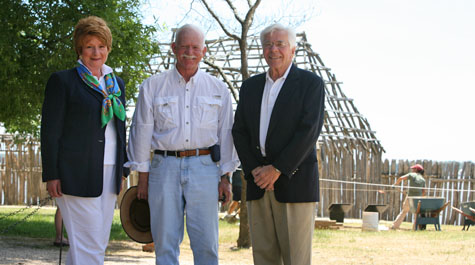Gift to W&M honors renowned Jamestown archaeologist
Since completing his master's in 1964, Kelso has pursued a highly successful career as an archaeologist, which has included the landmark 1996 discovery he and his team made of the original fort at Historic Jamestown Island, a find that dispelled widely held beliefs that the fort had been washed away by the James River.
"Rarely, you encounter someone who has made such remarkable accomplishments," said Margaret Nelson Fowler of Williamsburg. Fowler and Roy Hock, also of Williamsburg, came to know Kelso through his work at Jamestown. "We knew we wanted to do something to honor Bill," added Hock.
Fowler and Hock considered Kelso's experience at William & Mary, and together made a decision to endow the Dr. William M. Kelso Graduate Fellowship in Early American Studies with a gift of $250,000. The fellowship honors Kelso's life's work of early American archaeology, research and scholarship and will provide an entering William & Mary history, American studies or anthropology graduate student with stipend support and research expenses. The first fellowship will be awarded in spring 2011.
"Graduate fellowships like this one are significant enhancements to our program," said Carl Strikwerda, dean of Arts & Sciences at William & Mary. "These types of gifts allow us to attract and educate the next generation of scholars, people who will provide new insights about the past and help inspire students in the future. Bill Kelso is among our most accomplished alumni, and he certainly sets a high standard to which our students can aspire."
Kelso, who, in addition to his master's in history from the College, holds a bachelor's degree from Baldwin-Wallace College and a Ph.D. from Emory University, has served as the director of archaeology at Colonial Williamsburg's Carter's Grove, and Thomas Jefferson's Monticello and Poplar Forest.
"I hope that future students who receive this fellowship will be able to pick up and learn from my experience," said Kelso. "I want them to keep rediscovering. I want them to have access to the same opportunities that I had a chance to pursue when I studied at William & Mary," added Kelso, who himself benefitted from a graduate fellowship that he says was instrumental in allowing him to attend William & Mary.
"Bill is always interested in talking about his work, but never about himself," said Fowler. "I want people to know more about Bill and understand how persistent he has been in rediscovering a crucial part of the beginnings of America."
In 1993, Kelso was named director of archaeology for the Association for the Preservation of Virginia Antiquities (APVA) Jamestown Rediscovery project and set about trying to locate the James Fort, the remains of which he still believed existed despite contradictory views that the fort had been washed away. His persistence paid off and Kelso and his team had located the evidence of structures that comprised the fort. Today, Kelso's work continues at Jamestown with much of the fortification rediscovered and more than a million artifacts found that help tell the story of the first permanent English colony in North America.
 Skip to main content
Skip to main content

